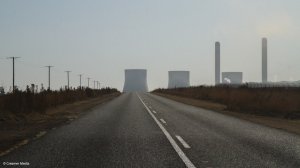Cabinet endorses more ambitious carbon pledge ahead of Glasgow summit
Cabinet has approved a revised – and more ambitious – Nationally Determined Contribution (NDC) carbon mitigation target range for 2030 ahead of the upcoming COP26 gathering, which will take place in Glasgow, Scotland, in November.
In a statement, Cabinet announced that South Africa had revised its 2030 climate change mitigation target range to 350 - 420 metric tons of carbon dioxide equivalent (Mt Co2-eq) for submission to the United Nations Framework Convention on Climate Change (UNFCCC).
The country's target range for 2025 has been revised to 398 - 510 Mt Co2-eq.
The new range represents an improvement on the 398 – 440 Mt CO2-eq range outlined in a draft NDC update for 2030 and released for public comment in March.
It is also a significant improvement on the 398 - 614 Mt CO2-eq range deposited with the UNFCCC in 2015 ahead of the Paris Climate Agreement.
Paris Agreement signatories are required to deposit NDCs every five years and South Africa deposited its first NDC with the UNFCCC in October 2015 and was meant to submit a new NDC last year, but COP26 was delayed as a result of the Covid-19 pandemic.
The Presidential Climate Commission (PCC) and Business Unity South Africa (Busa) both endorsed the 350 - 420 Mt Co2-eq range in their submissions on the draft NDC, with the PCC arguing that an increase in the level of ambition posed little downside risk to the country and offered considerable upside.
Busa, meanwhile, described the range as realistic based on achieving the objectives proposed in the country’s current policies, but said that meeting the target would require “technology, finance and comprehensive support” from the international community.
South Africa’s largest carbon emitter, Eskom, is hoping to use COP26 as an opportunity to market its just energy transition transaction, under which it aims to raise concessional finance to fund it own accelerated shift from coal, as well as to support workers, communities and businesses that will be negatively affected by coal decommissioning.
“The revised target range is aligned with all the stakeholders that contribute towards the country’s efforts,” Cabinet said in its statement.
The revised target range was also aligned to the recommendations of the Intergovernmental Panel on Climate Change (IPCC), it added.
In its most recent report, the IPCC said that mitigation efforts had to be accelerated during the current decade to sustain any prospect of limiting the rise in the average global temperature to 1.5 °C above pre-industrial levels.
The report stated that the 1.2 °C threshold has already been breached.
During a recent presentation to lawmakers, Forestry, Fisheries and the Environment Minister Barbara Creecy stressed that, while NDC pledges were not legally binding, South Africa had every intention of complying and would, thus, deposit a carbon-reduction range backed by research.
She warned, however, that besides South Africa’s moral obligation to contribute to reducing greenhouse-gas emissions, there was also a growing economic urgency to place the country on a lower-carbon trajectory, as doing nothing would pose “significant risks” as the European Union moved to implement a Carbon Border Adjustment Mechanism.
South Africa’s improved NDC offer, she indicated, would be combined with a negotiation stance that will seek to secure commitments from developed countries on both climate mitigation and adaptation.
Creecy bemoaned the fact that rich countries had not been honouring their $100-billion-a-year in climate financing and said that the figure would have to be significantly increased to meet the adaptation investment needs of a continent such as Africa.
She again argued that yearly climate finance contributions for rich countries in the form of grants, concessional loans and blended-finance instruments would need to be increased to about $750-billion by 2030 to support developing countries in building up climate resiliency and to enable them to contribute to mitigation.
The Bill, which has already gone through a public consultation process with stakeholders, seeks to provide a legal instrument towards the implementation of the National Climate Change Response Policy.
“It allows for the alignment of policies that will influence the country’s climate change response. It also provides for the transitional arrangement for the country to move towards a lower carbon and climate-resilient economy,” Cabinet said.
Article Enquiry
Email Article
Save Article
Feedback
To advertise email advertising@creamermedia.co.za or click here
Comments
Press Office
Announcements
What's On
Subscribe to improve your user experience...
Option 1 (equivalent of R125 a month):
Receive a weekly copy of Creamer Media's Engineering News & Mining Weekly magazine
(print copy for those in South Africa and e-magazine for those outside of South Africa)
Receive daily email newsletters
Access to full search results
Access archive of magazine back copies
Access to Projects in Progress
Access to ONE Research Report of your choice in PDF format
Option 2 (equivalent of R375 a month):
All benefits from Option 1
PLUS
Access to Creamer Media's Research Channel Africa for ALL Research Reports, in PDF format, on various industrial and mining sectors
including Electricity; Water; Energy Transition; Hydrogen; Roads, Rail and Ports; Coal; Gold; Platinum; Battery Metals; etc.
Already a subscriber?
Forgotten your password?
Receive weekly copy of Creamer Media's Engineering News & Mining Weekly magazine (print copy for those in South Africa and e-magazine for those outside of South Africa)
➕
Recieve daily email newsletters
➕
Access to full search results
➕
Access archive of magazine back copies
➕
Access to Projects in Progress
➕
Access to ONE Research Report of your choice in PDF format
RESEARCH CHANNEL AFRICA
R4500 (equivalent of R375 a month)
SUBSCRIBEAll benefits from Option 1
➕
Access to Creamer Media's Research Channel Africa for ALL Research Reports on various industrial and mining sectors, in PDF format, including on:
Electricity
➕
Water
➕
Energy Transition
➕
Hydrogen
➕
Roads, Rail and Ports
➕
Coal
➕
Gold
➕
Platinum
➕
Battery Metals
➕
etc.
Receive all benefits from Option 1 or Option 2 delivered to numerous people at your company
➕
Multiple User names and Passwords for simultaneous log-ins
➕
Intranet integration access to all in your organisation





















